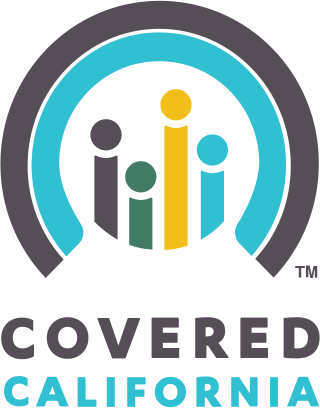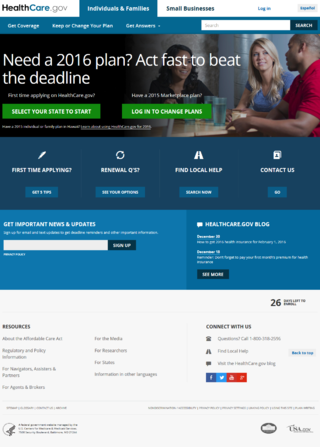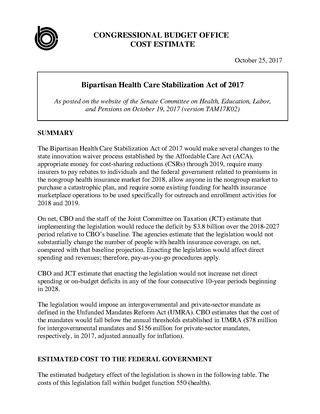Health insurance or medical insurance is a type of insurance that covers the whole or a part of the risk of a person incurring medical expenses. As with other types of insurance, risk is shared among many individuals. By estimating the overall risk of health risk and health system expenses over the risk pool, an insurer can develop a routine finance structure, such as a monthly premium or payroll tax, to provide the money to pay for the health care benefits specified in the insurance agreement. The benefit is administered by a central organization, such as a government agency, private business, or not-for-profit entity.

The Massachusetts health care reform, commonly referred to as Romneycare, was a healthcare reform law passed in 2006 and signed into law by Governor Mitt Romney with the aim of providing health insurance to nearly all of the residents of the Commonwealth of Massachusetts.

In the United States, health insurance coverage is provided by several public and private sources. During 2019, the U.S. population overall was approximately 330 million, with 59 million people 65 years of age and over covered by the federal Medicare program. The 273 million non-institutionalized persons under age 65 either obtained their coverage from employer-based or non-employer based sources, or were uninsured. During the year 2019, 89% of the non-institutionalized population had health insurance coverage. Separately, approximately 12 million military personnel received coverage through the Veteran's Administration and Military Health System.
In the United States, health insurance marketplaces, also called health exchanges, are organizations in each state through which people can purchase health insurance. People can purchase health insurance that complies with the Patient Protection and Affordable Care Act at ACA health exchanges, where they can choose from a range of government-regulated and standardized health care plans offered by the insurers participating in the exchange.
Members of the United States population between the ages of 18 and 29 who decide that it is in their financial best interest to forgo health insurance are sometimes referred to as young invincibles by the insurance industry, a term coined to express the idea that the young demographic perceives themselves as immune to sickness and injury. The argument is that these individuals are young and in good health, so they have a low risk of experiencing substantial health issues that would lead to large amounts of spending on health care. Further, this group tends to have a mentality of “it won’t happen to me” with regards to most causes of injury. Together, these beliefs lead to the young invincibles not purchasing insurance.

The Affordable Care Act (ACA), formally known as the Patient Protection and Affordable Care Act (PPACA) and colloquially known as Obamacare, is a landmark U.S. federal statute enacted by the 111th United States Congress and signed into law by President Barack Obama on March 23, 2010. Together with the Health Care and Education Reconciliation Act of 2010 amendment, it represents the U.S. healthcare system's most significant regulatory overhaul and expansion of coverage since the enactment of Medicare and Medicaid in 1965.

Covered California is the health insurance marketplace in the U.S. state of California established under the federal Patient Protection and Affordable Care Act (ACA). The exchange enables eligible individuals and small businesses to purchase private health insurance coverage at federally subsidized rates. It is administered by an independent agency of the government of California.
Health care finance in the United States discusses how Americans obtain and pay for their healthcare, and why U.S. healthcare costs are the highest in the world based on various measures.
The Affordable Care Act (ACA) is divided into 10 titles and contains provisions that became effective immediately, 90 days after enactment, and six months after enactment, as well as provisions phased in through to 2020. Below are some of the key provisions of the ACA. For simplicity, the amendments in the Health Care and Education Reconciliation Act of 2010 are integrated into this timeline.

HealthCare.gov is a health insurance exchange website operated by the United States federal government under the provisions of the Affordable Care Act or ACA, commonly referred to as “Obamacare”, which currently serves the residents of the U.S. states which have opted not to create their own state exchanges. The exchange facilitates the sale of private health insurance plans to residents of the United States and offers subsidies to those who earn between one and four times the federal poverty line, but not to those earning less than the federal poverty line. The website also assists those persons who are eligible to sign up for Medicaid, and has a separate marketplace for small businesses.
The Maryland Health Connection is the health insurance marketplace in the U.S. state of Maryland, created in accordance with the Patient Protection and Affordable Care Act.

DC Health Link is the health insurance marketplace for the District of Columbia, created pursuant to the Patient Protection and Affordable Care Act. DC Health Link is administered by the District's Health Benefit Exchange Authority.
This article summarizes healthcare in California.
King v. Burwell, 576 U.S. 473 (2015), was a 6–3 decision by the Supreme Court of the United States interpreting provisions of the Patient Protection and Affordable Care Act (ACA). The Court's decision upheld, as consistent with the statute, the outlay of premium tax credits to qualifying persons in all states, both those with exchanges established directly by a state, and those otherwise established by the Department of Health and Human Services.
The premium tax credit (PTC) is a refundable tax credit in the United States. It is payable by the Internal Revenue Service (IRS) to eligible households that have obtained healthcare insurance by a healthcare exchange (marketplace) in the tax year. It can be paid in advance directly to a healthcare insurance company to offset the cost of monthly health insurance premiums.

The American Health Care Act of 2017 was a bill in the 115th United States Congress. The bill, which was passed by the United States House of Representatives but not by the United States Senate, would have partially repealed the Affordable Care Act (ACA).

The Executive Order Promoting Healthcare Choice and Competition, also known as the Trumpcare Executive Order, or Trumpcare, is an Executive Order signed by Donald Trump on October 12, 2017, which directs federal agencies to modify how the Patient Protection and Affordable Care Act of the Obama Administration is implemented. The order included a directive to federal agencies to end rules forbidding employers from using health reimbursement arrangements (HRAs) to pay individual insurance premiums.

The Bipartisan Health Care Stabilization Act of 2017 was a 2017 proposed compromise reached by senator and HELP Committee chairman Lamar Alexander and senator and HELP Committee ranking member Patty Murray to amend the Affordable Care Act to fund cost-sharing reductions subsidies. The plan will also provide more flexibility for state waivers, allow a new "Copper Plan" or catastrophic coverage for those under 30, allow interstate insurance compacts, and redirect consumer fees to states for outreach. President Trump had stopped paying the cost sharing subsidies and the Congressional Budget Office estimated his action would cost $200 billion, cause insurance sold on the exchange to cost 20% more and cause one million people to lose insurance.
The cost sharing reductions (CSR) subsidy is the smaller of two subsidies paid under the Patient Protection and Affordable Care Act (ACA) as part of the healthcare system in the United States. The subsidies were paid from 2013 to 2017 to insurance companies on behalf of eligible enrollees in the ACA to reduce co-payments and deductibles. They were discontinued by President Donald Trump in October 2017. The nature of the subsidy as discretionary spending versus mandatory was challenged in court by the Republican-controlled House of Representatives in 2014, although payments continued when the ruling in favor of the GOP was appealed by the Obama administration. The non-partisan Congressional Budget Office (CBO) estimated that ending the payments would increase insurance premiums on the ACA exchanges by around 20 percentage points, resulting in increases in the premium tax credit subsidies, thereby adding nearly $200 billion to the budget deficits over the following decade. Critics argued the decision was part of a wider strategy to "sabotage" the ACA.
The Patient Protection and Affordable Care Act, often shortened to the Affordable Care Act (ACA) or nicknamed Obamacare, is a United States federal statute enacted by the 111th United States Congress and signed into law by President Barack Obama on March 23, 2010. Together with the Health Care and Education Reconciliation Act of 2010 amendment, it represents the U.S. healthcare system's most significant regulatory overhaul and expansion of coverage since the passage of Medicare and Medicaid in 1965. Once the law was signed, provisions began taking effect, in a process that continued for years. Some provisions never took effect, while others were deferred for various periods.







